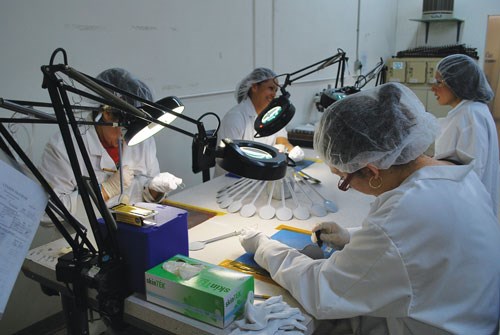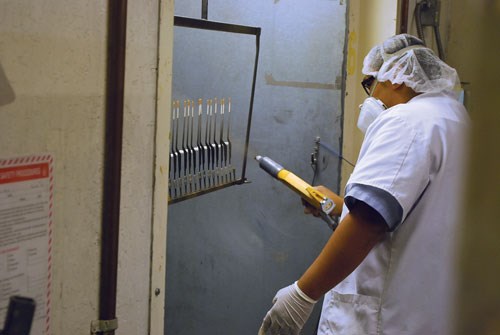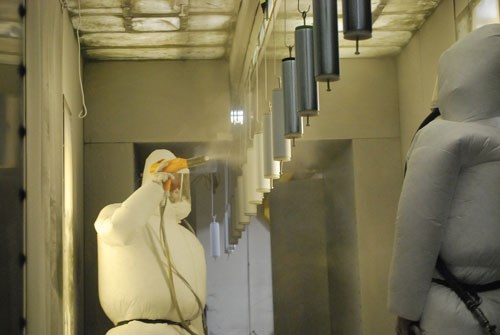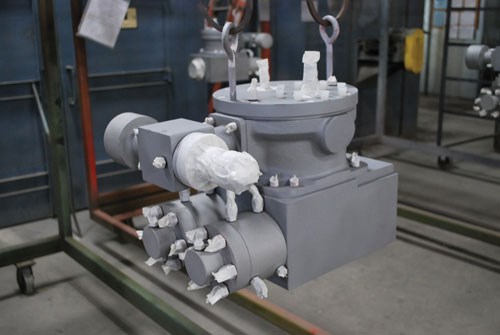Coater is Getting Healthy in California’s Central Valley
Advanced Industrial Coatings specializes in medical and food service finishes. The company’s 50,000-sq-ft plant contains a conveyorized powder coating line capable of handling massive amounts of coatings, and an environmental and climate-controlled area for scientific applications.
When one of Advanced Industrial Coatings’ clients visited its Stockton, Calif., finishing shop to see how it was coating heart defibrillator equipment in a high-tech control room, that customer came away more than impressed.
The super-clean and climate-controlled area that AIC uses for most scientific applications and medical device coating was impressive for its strict quality adherences and attention to detail.
“The customer watched their parts being processed and coated in the room, and they later told me they felt like we handled their part like someone working on fine jewelry,” says Dave Arney, founder and chief operating officer.
“It was a comment we took a lot of pride in because we handle all our customer’s parts with that same precision. But it was truly wonderful that they noticed it.”
A lot of companies have noticed AIC over the years, and several, such as Johnson & Johnson, Hewlett Packard and Phillips Medical, have beaten a path to the company’s door.

The clean and climate-controlled area is used for most scientific applications and medical device coating.
Coating for a Variety of Industries
Established in 1984, AIC specializes in several manufacturing sectors, including medical, IT, automotive, energy, aerospace and food processing. The company’s 50,000-sq-ft plant contains a conveyorized powder coating line capable of handling massive amounts of coatings, and the aforementioned environmental and climate-controlled area for scientific applications. AIC is an Axalta Coating Systems’ Certified Star Coater and a Whitford Worldwide Approved Quality Coater, and it is these titles and certifications that get the company in the front door of many Fortune 500 manufacturers.
Steve Hockett, vice president of production, says his company applies a variety of coatings for its growing list of medical and technology clients, including Phillips, Lam Research, Applied Materials, Sanmina and FMC Technologies.
“A significant amount of our volume and overall revenue comes from the medical industry,” Hockett says.
Meeting High Service Temps
Chief among the medical coatings is Arkema’s Rislan nylon, which AIC applies to medical forceps, defibrillator paddles, appliance racks, robotic parts, semiconductor parts and others. Because Rislan is able to endure high service temperatures, Hockett says it can be autoclaved in medical applications and has excellent chemical-, impact-, corrosion- and abrasion-resistance.

Medical parts are masked before heading into the powder spray booth.
A large majority of AIC’s processes involve Rislan and the Whitford Corp.’s Xylan fluoropolymer coatings, which are dry film lubricants that can be applied to most metals, plastics and ceramics castings because of their low-friction and nonstick properties.
“Those two are primarily used as insulation coatings because there is often an electrical current going through the parts, usually in medical devices,” Hockett says. “Of course, they’re also great coatings for when the parts are reused and need to be sterilized.”
AIC has its own autoclave to test certain parts to make sure they are holding up to the high temperatures during sterilization, often running the batch of parts through as much as 25 autoclave cycles during testing.
“We just want to make sure that what we are providing will hold up out in the field,” Hockett says. “We’ve been doing this testing for 20 years, and we’ve never had a failure in our system yet.” It is those types of standards that attract manufacturers to AIC, including FMC Technologies’ Schilling Robotics division, which manufactures remotely operated vehicles and manipulator arms, including those used in deep-sea explorations in oil and gas field operations.
Andy Lyons, director of manufacturing technologies for Davis, Calif.-based FMC Technologies, says he has been working with AIC for several years after the company was recommended to FMC through a paint manufacturer’s representative.
“When we entered into a new product line with very stringent painting and coating specifications, we searched the entire West Coast for a vendor before picking AIC,” Lyons says. “They flew through the initial audit and qualification process with ease. Their delivery and pricing are great, and the quality is uncompromising. We couldn’t be happier.”

AIC is an Axalta Powder Coatings Certified Star Coater and a Whitford Worldwide Approved Quality Coater.
Serving Food & Beverages
Another product offered by AIC is Solvay Solexis’ Halar coating, which it has been using on impellers, chemical tanks, chemical pipes and other parts that have chemical or pharmaceutical applications, particularly because it is solvent resistant to 300°F.
But perhaps one of the biggest industries that AIC is servicing is the food processing sector. The company’s location in the heart of California’s Central Valley is within one of the largest food-growing and processing areas in the United States. This area of about 60 miles wide by almost 450 miles long includes such cities as Sacramento, Fresno, Bakersfield, Stockton and Modesto. Although it makes up less than one percent of the U.S. acreage, the Central Valley accounts for more than eight percent of all agriculture grown in the country, according to state officials, and it is the largest food exporter in the U.S., providing 15 percent of all exports. More than 6,000 growers harvest more than 250 different crops, including tomatoes, almonds, grapes, cotton, apricots and asparagus.
Most of the food processors in the area handle fruits and vegetables, meats, dairy products and other raw foods in machines and equipment that need to be both corrosion-resistant and approved by the Food and Drug Administration.
That’s where AIC comes in, using its various coating methods and surface finishing products to fulfill the needs of an ever-growing industry.
Lately, the company also has seen growth in business from cheese plants and other processors who use augers in their manufacturing lines, including those in the bagel industry who use the equipment to mix breads and other materials.

AIC applies coatings to medical forceps, defibrillator paddles, appliance racks, robotic parts, semiconductor parts and others.
According to the Office of Economic Development at Cerritos College in Norwalk, Calif., about 33 percent of the roughly 6,000 processors are in the baked goods and tortilla industry and often require heavy-duty coated equipment to mix batches of flour. Just over 25 percent of the Central Valley food processors are in the beverage sector, while another 8 percent are in fruits and vegetables, 7 percent in meat processing, 5 percent in dairy and 4 percent in sugar.
“You have various requirements with those types of products that need coating for the food industry,” Arney says. “It has to be an FDA-approved surface, it has to be slippery to process the foods and not stick, and it has to be corrosion resistant because a lot of fruits and vegetables are corrosive with their acids.”
Several of the products that AIC coats for the food industry are parts from conveyor systems that move fruits and vegetables throughout a processing facility. Arney says those materials also need to have non-stick surfaces because of secretions from the agricultural products.
“Sugar is a big culprit because it will stick to a lot of things and clog up a line,” he says.
Secret: Diversity
Thanks to the medical and food processing industries, AIC has maintained a steady flow of parts to coat through its powder coated conveyor line and a batch area, which consists of five coating booths for liquid and powder, and five ovens for curing.

AIC has grown in large part because of the food processing plants in California’s Central Valley, which need to have coated parts for their machinery.
“The secret for us to remain as versatile and diverse as possible to serve our clients is to run a pretty lean operation,” Hockett says.
One of the trends the company has begun seeing is that most of the new work it is generating is for products heading outside of the U.S., so Arney says a key for future growth will be to increase the amount of product exported to other nations.
AIC’s “bread-and-butter,” so to speak, will still remain the medical and food service industry, though.
“People will always have to eat, and they’ll always need medical care,” Hockett says.
For information on Advanced Industrial Coatings, please call 877-927-2700 or visit AIC-coatings.com.
Related Content
Powder Coater Leverages Its Manufacturing Mindset for Success
As a former motorcycle manufacturer, this powder coating Top Shop benefits from understanding the finishing industry from a customer’s perspective.
Read MoreCatalytic Gel Ovens Offer Small Operational Footprint
WolfRayet catalytic gel ovens offer small operational footprints while also providing a way to improve on existing convection curing.
Read More5 Maintenance Tips for Gas Catalytic IR Ovens
Basic and periodic preventive maintenance is essential for avoiding oven downtime.
Read MoreIHEA Announces 2023-2024 Board of Directors
The Industrial Heating Equipment Association has announced its Board of Directors and Executive Officers for the coming year.
Read MoreRead Next
Episode 45: An Interview with Chandler Mancuso, MacDermid Envio Solutions
Chandler Mancuso, technical director with MacDermid Envio discusses updating your wastewater treatment system and implementing materials recycling solutions to increase efficiencies, control costs and reduce environmental impact.
Read MoreDelivering Increased Benefits to Greenhouse Films
Baystar's Borstar technology is helping customers deliver better, more reliable production methods to greenhouse agriculture.
Read MoreA ‘Clean’ Agenda Offers Unique Presentations in Chicago
The 2024 Parts Cleaning Conference, co-located with the International Manufacturing Technology Show, includes presentations by several speakers who are new to the conference and topics that have not been covered in past editions of this event.
Read More





















